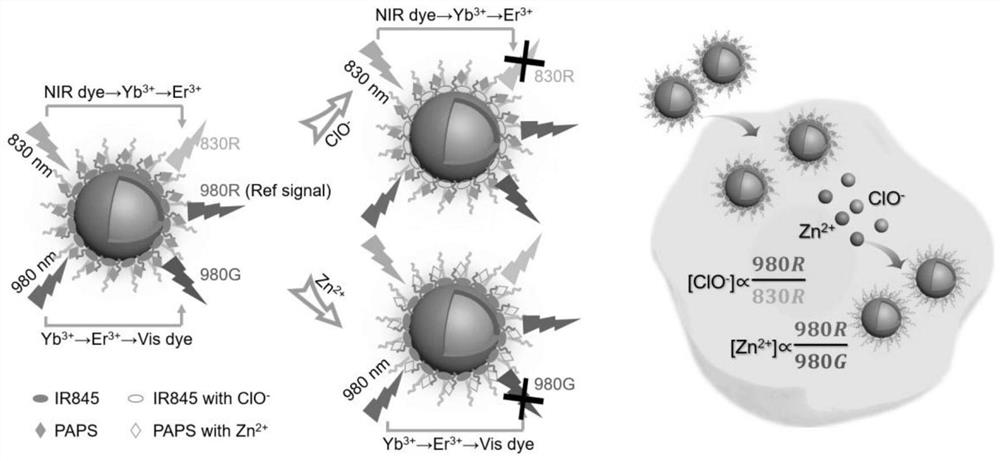Method for simultaneously detecting hypochlorite ions and zinc ions in cells based on up-conversion fluorescence probe
A technology of hypochlorite and fluorescent probes, applied in chemical instruments and methods, fluorescence/phosphorescence, luminescent materials, etc.
- Summary
- Abstract
- Description
- Claims
- Application Information
AI Technical Summary
Problems solved by technology
Method used
Image
Examples
preparation example 1
[0106] Preparation of double excitation double emission upconversion fluorescent probe UCNP-IR845-PAPS-F127:
[0107] (1) 1mmol oil-soluble nanoparticles NaYF 4 :Yb,Er@NaYF 4 : Yb and 1 μmol of the dye IR845 were dispersed in 20 mL of solvent chloroform, mixed for one hour to obtain solution 1;
[0108] (2) Dissolve 40mg of F127 in 2mL of chloroform, and add it dropwise to solution 1 under constant stirring to obtain solution 2;
[0109] (3) The solution two is rotary evaporated to remove the solvent trichloromethane, and after the volatilization of the trichloromethane is completed, it is redispersed in the aqueous solution to obtain the solution three;
[0110] (4) 48 μmol of visible light dye molecule PAPS is evenly dispersed in the aqueous solution, and the PAPS aqueous solution is added dropwise to the solution three under constant stirring to obtain solution four, and the stirring is continued overnight;
[0111] (5) After the step (4) is completed, centrifuge and was...
Embodiment 1
[0112] Example 1 Detection of hypochlorite ions by double-excitation and double-emission up-conversion fluorescent probes:
[0113] (1) Disperse the up-converting fluorescent probe prepared in Preparation Example 1 above in water to prepare a dispersion solution with a concentration of 200 mM. , 70, 80, 90 and 100 μM target detection substance (hypochlorite ion) reacted for 30 minutes;
[0114] (2) Measure the upconversion luminescence intensity of the solution in the step (1) on the FLS980 fluorescence spectrometer;
[0115] (3) Take the concentration of the hypochlorous acid to be measured in the mixed solution as the abscissa, and the up-conversion luminescence intensity corresponding to 830nm excitation as the ordinate to draw the concentration-dependent standard curve of the hypochlorous acid, and calculate the detection limit.
[0116] Such as Figure 5 As shown, in the range of 0-50 μM, the higher the concentration of hypochlorite ions, the lower the corresponding up-...
Embodiment 2
[0117] Example 2 Utilizes double-excitation double-emission up-conversion fluorescent probe to detect zinc ions:
[0118] (1) Disperse the up-converting fluorescent probe prepared in Preparation Example 1 above in water to prepare a dispersion solution with a concentration of 200 mM. , 70 and 80 μM target detection substance (zinc ion) reacted for 30 minutes;
[0119] (2) Measure the upconversion luminescence intensity of the solution in the step (1) on the FLS980 fluorescence spectrometer;
[0120] (3) Taking the concentration of zinc ions to be measured in the mixed solution as the abscissa, and the up-conversion luminescence intensity corresponding to 980nm excitation as the ordinate, draw the concentration-dependent standard curve of the zinc ions, and calculate the detection limit.
[0121] Such as Figure 6 As shown, in the range of 0-27 μM, the higher the concentration of zinc ions, the lower the intensity of upconverted green light corresponding to the mixed solution...
PUM
| Property | Measurement | Unit |
|---|---|---|
| absorption wavelength | aaaaa | aaaaa |
| particle size | aaaaa | aaaaa |
Abstract
Description
Claims
Application Information
 Login to View More
Login to View More - R&D
- Intellectual Property
- Life Sciences
- Materials
- Tech Scout
- Unparalleled Data Quality
- Higher Quality Content
- 60% Fewer Hallucinations
Browse by: Latest US Patents, China's latest patents, Technical Efficacy Thesaurus, Application Domain, Technology Topic, Popular Technical Reports.
© 2025 PatSnap. All rights reserved.Legal|Privacy policy|Modern Slavery Act Transparency Statement|Sitemap|About US| Contact US: help@patsnap.com



